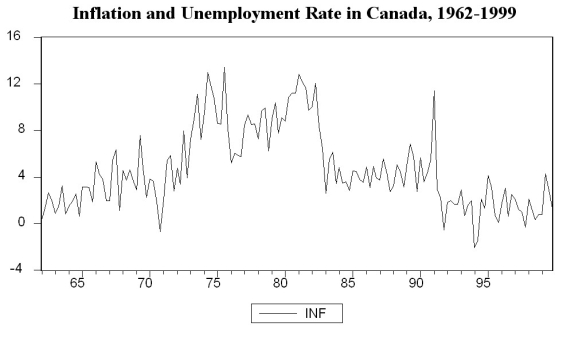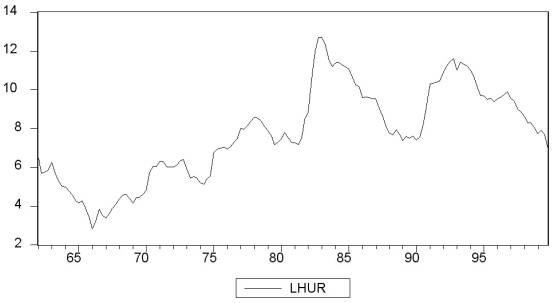You have collected quarterly data on Canadian unemployment (UrateC)and inflation (InfC)from 1962 to 1999 with the aim to forecast Canadian inflation.
(a)To get a better feel for the data,you first inspect the plots for the series. 
 Inspecting the Canadian inflation rate plot and having calculated the first autocorrelation to be 0.79 for the sample period,do you suspect that the Canadian inflation rate has a stochastic trend? What more formal methods do you have available to test for a unit root?
Inspecting the Canadian inflation rate plot and having calculated the first autocorrelation to be 0.79 for the sample period,do you suspect that the Canadian inflation rate has a stochastic trend? What more formal methods do you have available to test for a unit root?
(b)You run the following regression,where the numbers in parenthesis are homoskedasticity-only standard errors:  = 0.49- 0.10 Inft-1 - 0.39 △InfCt-1 - 0.33 △InfCt-2 - 0.21 △InfCt-3 + 0.05 △InfCt-4
= 0.49- 0.10 Inft-1 - 0.39 △InfCt-1 - 0.33 △InfCt-2 - 0.21 △InfCt-3 + 0.05 △InfCt-4
(0.28)(0.05)(0.09)(0.09)(0.09)(0.08)
Test for the presence of a stochastic trend.Should you have used heteroskedasticity-robust standard errors? Does the fact that you use quarterly data suggest including four lags in the above regression,or how should you determine the number of lags?
(c)To forecast the Canadian inflation rate for 2000:I,you estimate an AR(1),AR(4),and an ADL(4,1)model for the sample period 1962:I to 1999:IV.The results are as follows:  = 0.002 - 0.31 △InfCt-1
= 0.002 - 0.31 △InfCt-1
(0.014)(0.10)  = 0.021 - 0.46 ΔInfCt-1 - 0.39 ΔInfCt-2 - 0.25 ΔInfCt-3 + 0.03 ΔInfCt-4
= 0.021 - 0.46 ΔInfCt-1 - 0.39 ΔInfCt-2 - 0.25 ΔInfCt-3 + 0.03 ΔInfCt-4
(0.158)(0.10)(0.11)(0.08)(0.07)  = 1.279 - 0.51 ΔInfCt-1 - 0.44 ΔInfCt-2 - 0.30 ΔInfCt-3 - 0.02 ΔInfCt-4
= 1.279 - 0.51 ΔInfCt-1 - 0.44 ΔInfCt-2 - 0.30 ΔInfCt-3 - 0.02 ΔInfCt-4
(0.57)(0.10)(0.11)(0.09)(0.08)
- 0.16 UrateCt-1
(0.07)
In addition,you have the following information on inflation in Canada during the four quarters of 1999 and the first quarter of 2000:
Inflation and Unemployment in Canada,First Quarter 1999 to First Quarter 2000
 For each of the three models,calculate the predicted inflation rate for the period 2000:I and the forecast error.
For each of the three models,calculate the predicted inflation rate for the period 2000:I and the forecast error.
(d)Perform a test on whether or not Canadian unemployment rates Granger-cause the Canadian inflation rate.
Definitions:
Expensive Extra Equipment
Items or tools that are not included with the basic package of a product and are often high in price.
Test Drive
A trial use of a car before purchase, allowing potential buyers to experience the vehicle's performance, features, and suitability for their needs.
Foot-In-The-Door Approach
A persuasion technique that involves getting a person to agree to a small request to increase the chances that they'll agree to a larger request later.
Abnormal Behavior
Refers to patterns of emotion, thought, and action deemed pathological for one or more reasons, including being unusual, causing distress, or violating societal norms.
Q7: You can determine the lag lengths in
Q8: You would like to find the effect
Q14: All of the following are reasons for
Q16: When there is a single instrument and
Q19: Present alternative estimators for causal effects using
Q26: The OLS estimator<br>A)has the multivariate normal asymptotic
Q32: At a large Midwestern university,a simple random
Q40: (Requires Appendix material)At a recent county fair,you
Q48: Ten couples are participating in a small
Q49: The advantage of using heteroskedasticity-robust standard errors